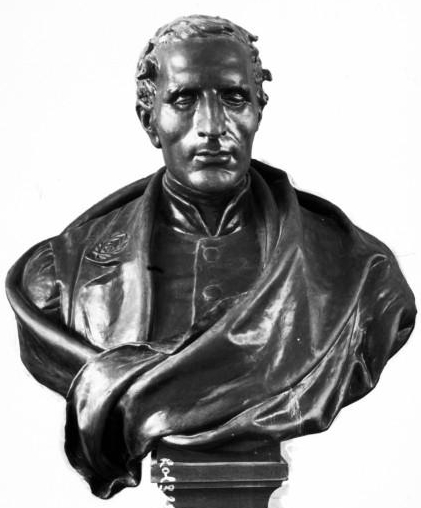<Back to Index>
- Inventor Louis Braille, 1809
- Sculptor Wilhelm Lehmbruck, 1881
- Minister of the Interior Baron Alexander von Bach, 1813
PAGE SPONSOR

Louis Braille (January 4, 1809 – January 6, 1852) was the inventor of braille, a system of reading and writing used by people who are blind and visually impaired. One reads braille by passing one's fingers over characters, each of which is an arrangement of one to six embossed points. The system has been adapted for languages worldwide.
Braille was born in Coupvray, a small town located southeast of Paris in Seine - et - Marne. His father was a saddlemaker, who also crafted harnesses, bags and leather straps. As soon as he could walk, Louis spent time playing in his father's workshop. At age three, he scratched his right eye while making holes in a piece of leather with a pruning knife or awl that was too heavy for him. There was nothing anyone could do except patch and bind the affected eye. The wound became severely infected and spread to his left eye causing his blindness.
At the age of 10, Braille earned a scholarship to the National Institute for the Blind Youth in Paris, one of the first of its kind in the world. However, living conditions in the school were poor. Louis was served stale bread and water, and students were sometimes abused or locked up as a form of punishment.
Despite these circumstances, Braille proved to be a bright and creative student. His ear for music enabled him to become an accomplished cellist and organist in classes taught by Jean - Nicholas Marrigues. (Later in life, his musical talents led him to play the organ for churches all over France, and he held the position of organist in Paris at the Church of Saint - Nicolas - des - Champs 1834 and at the Church of Saint - Vincent - de - Paul in 1845.)
Children at the school were taught basic craftsman skills and simple trades. They were also taught how to read by feeling raised letters (a system devised by the school's founder, Valentin Haüy). However, because the raised letters were made using paper pressed against copper wire, the students never learned to write. Another disadvantage was that the letters weighed a lot and whenever people published books using this system, they put together a book with multiple stories in one in order to save money. This made the books sometimes weigh over a hundred pounds. The school had only three books, all of which Louis read.
In 1821, Charles Barbier, a former Captain in the French Army, visited the school. Barbier shared his invention called "night writing", a code of 12 raised dots and a number of dashes that let soldiers share
top secret information on the battlefield without having to speak. The
code was too difficult for Louis to understand, but it inspired him to
think about developing a system of his own. Louis
Braille began to invent his raised - dot system with his father's
stitching awl, the same implement with which he had blinded himself,
completing it at age 15, in 1824. Rather than 12 raised dots used in
Barbier, his system uses only six dots, possibly influenced by wooden
dice his father had given to him. Braille's new system had several
advantages. The six dot system allows the recognition of letters with a
single fingertip, which enables comprehension of all the dots at once
with no movement or repositioning of fingers that slows understanding
in systems requiring more dots. The dots are organized into patterns
that keep the system easy to learn. The Braille system also offers
numerous benefits over Haüy's raised letter method, the most
notable being the ability to both read and write an alphabet. Another
very notable benefit is that because they were dots just slightly
raised, volumes of text could be smaller, lighter, and easier to
produce. Braille later extended his system to include notation for mathematics and music. In 1829, he published the first book about his system, entitled Method of Writing Words, Music, and Plain Songs by Means of Dots, for Use by the Blind and Arranged for Them. This book was printed by using the raised letter method (“relief linéaire” in French). In
1839 he published details of a method he had developed for
communication with sighted people, using patterns of dots to
approximate the shape of printed symbols. With his friend Pierre Foucault, he went on to develop a Braille typewriter to speed up the somewhat cumbersome system. Braille
became a well respected teacher at the Institute. Although he was
admired and respected by his pupils, his writing system was not taught
at the Institute during his lifetime. He died in Paris of tuberculosis in
1852 at the age of 43, and was buried in Coupvray. His body was
disinterred at the centenary of his death in 1952 and he was reinterred
with honors in the Panthéon in Paris. His system was finally officially recognized in France two years after his death, in 1854. The
200th anniversary of his birth in 2009 was widely celebrated throughout
Europe by exhibitions and symposiums about life and achievements.
Belgium and Italy struck 2 euro coins, India struck a 2 rupee coin, and
the USA struck a one dollar coin to mark the event.